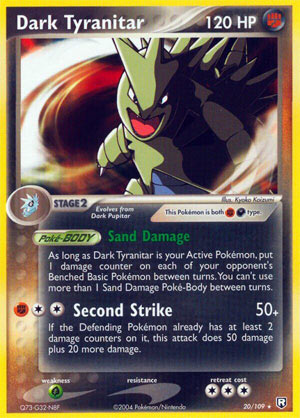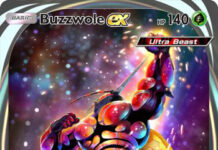
Dark Tyranitar
– Team Rocket Returns #020
Date Reviewed:
March 28, 2019
Ratings Summary:
See Below
Ratings are based on a 1 to 5 scale. 1 is horrible. 3 is average. 5 is great.
Reviews Below:
 Otaku Dark Tyranitar (EX – Team Rocket Returns 20/109) was not the first Dark Tyranitar card – that would be Dark Tyranitar (Team Rocket 11/105) – nor is it the only Dark Tyranitar card from its own set – Dark Tyranitar (EX – Team Rocket Returns 19/109). I vaguely recall players trying to make the original Dark Tyranitar competitive, but never coming close to succeeding. For a time, lists running one or both Dark Tyranitar from EX – Team Rocket were the decks to beat. By the time of the 2005 World Championships, nine months after Dark Tyranitar (EX – Team Rocket Returns 19/109) and Dark Tyranitar (EX – Team Rocket 20/109) had released, their influence had ebbed. However, they were still strong enough that Takashi Yoneda piloted a deck featuring the two Dark Tyranitar to second place in the Senior Age Division or the 2005 World Championship. We’re also reviewing Dark Tyranitar (EX – Team Rocket Returns 19/109) today; we once again have two cards so closely related we need to discuss them at the same time but different enough they really need their own entries. Don’t be surprised if I repeat myself a lot in the reviews, however, since the two cards have so much in common. After all, I’ve got to at least touch on several mechanics no longer used or used the same way in the modern game, in addition to more general differences between the metagames. Dark Tyranitar does not count against Tyranitar with respect to the 4-Copy Rule; you could run four of each in the same deck. The other Dark Tyranitar cards do count against each other for the 4-Copy Rule. Dark Tyranitar evolves from Dark Pupitar but Dark Pupitar evolves from regular Larvitar. This is different from other major examples of the “owner” mechanic, as cards like Team Magma’s Aggron would Evolve from Team Magma’s Lairon and that from Team Magma’s Aron. For those unfamiliar with the “owner” mechanic, it is when something in the card’s name denotes it as belonging to a specific character or group. There were pieces of themed support just for Pokémon with “Dark” or “Rocket’s” in their name at this time, and I thought there were counters or at least beneficial effects which excluded them but I’m not finding them with my searches; maybe I’m remembering it wrong or maybe I’m just using the wrong keywords/phrases in my inquiries. Dark Tyranitar is a Stage 2 Pokémon, but it doesn’t mean the same thing now as it did back then… in fact, you might think of it as the opposite. Dark Tyranitar released at a time when Basic Pokémon were usually “filler” and Evolutions dominated the metagame. Part of this was an intentional imbalance, an overcorrection due to the dominance by Basic Pokémon in the early days of the game. Part of this was due to the often stifling first-turn rules of the time, something so complicated it deserves its own article, but I’m afraid I lack the time or detailed knowledge for it. The final piece was Rare Candy; before the Black & White-era, it not only allowed you evolve a Basic Pokémon directly to the corresponding Stage 2 but could do so the first turn that Pokémon was in play, possibly your first turn of the game (when the first-turn rules cooperated). Back then you could even use it to evolve the selected Basic into the correct Stage 1 form, helping those out as well. Dual-Type Pokémon are, overall, rare in the history of the Pokémon TCG, even though they’re quite common in the video games. This Dark Tyranitar is both [F] and [D], corresponding to its video game dual-Typing of Rock and Dark. However, this is unusual as dual-Types in EX – Team Rocket don’t usually do that, instead just adding [D] to one of a card’s usual TCG Types, representing the “corruptive” influence of villainous Trainers. It just ends up being accurate for Pokémon like this Dark Tyranitar. Useful, as well; [F] Weakness was still abundant back then, enough to compensate for [F] Resistance also being relatively common. [D] Weak Pokémon, just like now, are the [P] Pokémon which represent the TCG Ghost-Type… and those are normally [F] Resistant in the TCG. The net effect is Dark Tyranitar hits one of these for (double damage – 30), first applying the Weakness to [D] Types before the Resistance to [F] Types. It also would allow Dark Tyranitar to benefit from the +10 damage bonus provided by the Special Energy card named Darkness Energy, except it already could at this time because the card provides the same bonus to Pokémon with [D] in their name. In unlikely event you decide to goof off with these cards in Unlimited, know that the wording of the latest version of the Special Energy version of Darkness Energy no longer provides the damage bonus based on a card’s name, just the typing. Dark Tyranitar has 120 HP, and while that is pretty small for a Stage 2 Pokémon now, it was the maximum printed allowed for any Stage of Evolution that was not also a Pokémon-ex. Yes, lower-case “ex”; these are the predecessors of Pokémon-EX/GX, basically Pokémon-GX without GX-attacks and less 15 years worth of power creep. It was very hard to OHKO this number back then, and you needed a solid deck played well if you wanted to ensure a 2HKO (Weakness excluded). Weakness wouldn’t guarantee a OHKO back then but made for easy 2HKOs when it didn’t. Its [G] Weakness was not safe, but might have been better than the [F] Weakness of its counterpart at the time. The lack of Resistance was the worst, but still fairly typical at the time. The Retreat Cost of [CCC] was more painful than it is now. What made this card famous was its Poké-Body, “Sand Damage”. What is a Poké-Body? Right now, the only non-attack Pokémon-based effects are Abilities and they work similarly enough I won’t go into great detail explaining them; just know the that Poké-Bodies and Poké-Powers (they’ll come up later) are like Abilities but not completely identical, and that card effects which talk about one do not apply to the other. Sand Damage only works while this Dark Tyranitar is active; you place a damage counter on each of your opponent’s Pokémon between turns. Typical HP scores were much lower than they are right now, so this was more like placing one-and-a-half damage counters between turns. Dark Tyranitar has a single attack, “Second Strike” for [FCC]. It does 50 damage to your opponent’s Active, plus another 20 if there are at least two damage counters already on whatever you just hit. At the time, [FCC] on a Stage 2 was likely to buy a good 50 damage, so this was neither good nor bad on its own. Double Colorless Energy wasn’t in the cardpool, but we had things like Double Rainbow Energy, R Energy, and Scramble Energy. Even if you couldn’t attack, the Poké-Body meant you could fake it; all in all, a good package deal. Now let us put it all together. Hopefully, you’ve read the review that also went up today, detailing Dark Tyranitar (EX – Team Rocket Returns 20/109), The short version is that it had the same Stage and HP as this version but slightly different Typing (purely a [D] Type) and three attacks. The first was just good for 10 damage per Energy attached to itself, sufficient for when you couldn’t use the other attacks. The second needed [DCC] to do 20 to all of your opponent’s Pokémon; decent when you remember the lower HP scores and damage output of the day but also that you couldn’t meet the [D] requirement without using Special Energy cards. Finally, for a massive [DDCCC] investment, it could do an underwhelming 70 damage… but against Pokémon-ex it would do 120. Pokémon-ex are similar to modern Pokémon-GX and not to be confused with Pokémon-EX (capitalization matters). With the lower HP scores, that third attack could OHKO any Basic and some Stage 1 Pokémon-ex; with Spinning Tail and/or its counterpart’s Sand Damage as a lead-in, you could fake a OHKO on moderately-sized Stage 1 Pokémon and small Stage 2s. I was surprised by the lack of Surprise! Time Machine in Takashi Yoneda’s build, as I used them in my own version of the deck. I thought it was handy being able to swap between the two versions of Dark Tyranitar on the fly, but I didn’t exactly have the wins to back that up. What most of us also got right was combining Sand Damage with Desert Ruins (the Shrine of Punishment for its day) and Ancient Technical Machine [Rock]. After just a few turns, all of your opponent’s Pokémon would have enough damage counters on them that those Evolved from the typical (40 to 60 HP) Basic Pokémon of this time would be KO’d by bouncing their highest Stage of Evolution… especially as most Stage 2 had skipped their Stage 1 states via Rare Candy. It was so effective, we eventually saw cards like Battle Frontier, which disabled Sand Damage as well as the “Quick Search” Poké-Power Pidgeot (EX – Fire Red & Leaf Green 10/112). Fortunately, the deck had Dark Tyranitar (EX – Team Rocket Returns 19/109) as an alternate or even main attacker, preventing it from being shutdown entirely by that Stadium. Ratings Standard: N/A Expanded: N/A Limited: 4/5 Dark Tyranitar (EX – Team Rocket Returns 20/109) links our other recent Throwbacks together. Besides sharing a name (and World Championship deck) with its set-mate, it was one of the many cards badly punished by the release of Battle Frontier and able to benefit from both Ancient Technical Machine [Rock] and Surprise! Time Machine. |
We would love more volunteers to help us with our Card of the Day reviews. If you want to share your ideas on cards with other fans, feel free to drop us an email. We’d be happy to link back to your blog / YouTube Channel / etc. 😉
Click here to read our Pokémon Card of the Day Archive. We have reviewed more than 3500 Pokemon cards over the last 17+ years!



